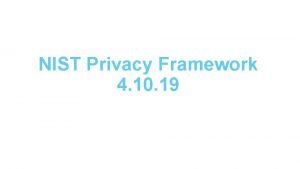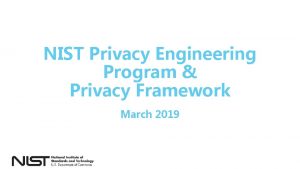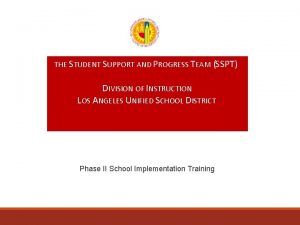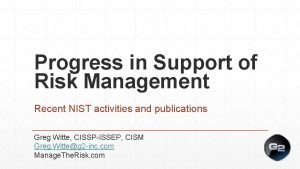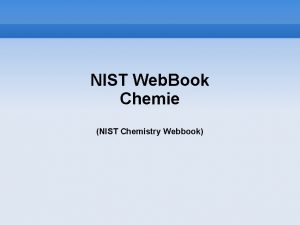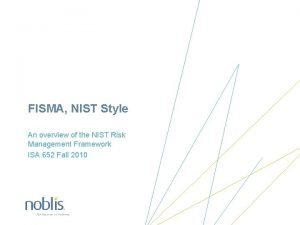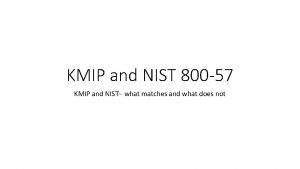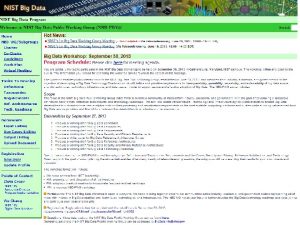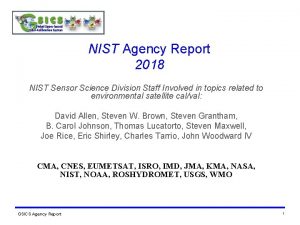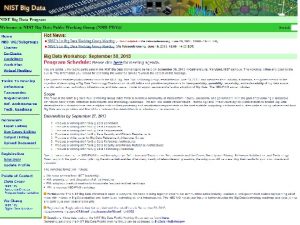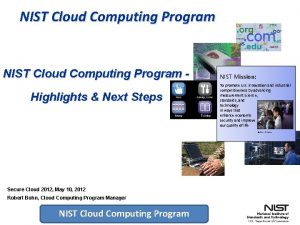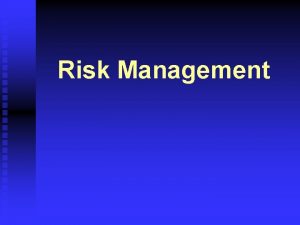Progress in Support of Risk Management Recent NIST


















- Slides: 18

Progress in Support of Risk Management Recent NIST activities and publications

National Institute of Standards and Technology ▪ G 2 is a small business that is proud to provide contractor support to NIST ▪ We don’t speak for NIST, but pleased to speak about NIST’s great work ▪ NIST’s mission is to develop and promote measurement, standards, and technology to enhance productivity, facilitate trade, and improve the quality of life. ▪ Federal, non-regulatory agency around since 1901 ▪ Agency of U. S. Department of Commerce Advanced Manufacturing IT and Cybersecurity Healthcare Forensic Science Disaster Resilience Cyber-physical Systems Advanced Communications

Relevant NIST & NCCo. E Activities ▪ NIST’s Smart Grid efforts provide strategic planning to modernize and stabilize the national grid. ▪ National Cybersecurity Center of Excellence (NCCo. E) - a collaborative hub where industry organizations, government agencies, and academic institutions work together to address pressing cybersecurity issues ▪ Asset Management ▪ Identity and Access Management (Id. AM) ▪ Situational Awareness

Audience Poll: How many here are using the NIST Framework?

Several Relevant Frameworks to Leverage ▪ Cyber-Physical Systems (CPS) Framework ▪ Privacy Engineering Framework ▪ Baldrige Excellence Framework ▪ Framework for Improving Critical Infrastructure Cybersecurity (or the Cybersecurity Framework) ▪ Risk Management Framework ▪ NICE Framework (Workforce)

Cyber-Physical Systems Framework Available from: https: //pages. nist. gov/cpspwg/

Io. T Security and Privacy Risk Considerations ▪ Cybersecurity for Internet of Things Program and the Privacy Engineering Program ▪ Seeking insights from stakeholders on preliminary ideas for improving security and privacy risk management for Io. T ▪ Considering developing guidance for federal agencies, though much of its content may be useful for other organizations. ▪ Scoping Io. T for guidance to cover the portions where orgs may be at greatest need of information on security and privacy risk management. ▪ Discussion draft (search for NIST IOT discussion draft) ▪ Always evolving – see new SP 500 -325, Fog Computing Conceptual Model

Cybersecurity Framework

Cybersecurity Framework v 1. 1 ▪ Expected release in April ▪ Clarifies use of Framework Components (i. e. , Implementation Tiers and Profiles) ▪ Provides guidance on self assessment metrics and measurements ▪ Adds the concept of identity proofing and expands authorization ▪ Adds Supply Chain Category ▪ Now 23 Categories, and 108 Subcategories ▪ Working on moving Informative References to an online database

Self-Regulation ▪ Many recent NIST RFI respondents continued to request that the Framework remain voluntary ▪ Many organizations want to do the right thing but need a flexible approach ▪ Some of the “old ways” forced prescriptive rules with criteria that didn’t even apply 10

Self-Regulation ▪ Effective pressure to “do the right thing” ▪ We often hear concerns from organizations that want assurance that they are doing “enough”, both for their own due diligence and also to avoid penalties 11

Cybersecurity Framework and Regulation ▪ NIST’s Frameworks complement, don’t compete with most regulatory frameworks ▪ Some models are less prescriptive ▪ Others are quite specific but can align to the higher-level functions and categories

NERC CIP Example: CIP-013 -1 ▪ High Level outcomes in NIST CSF v 1. 1 ▪ ID. SC-1: SCRM processes are identified, established, assessed, managed, and agreed to by organizational stakeholders ▪ ID. SC-2: Identify, prioritize and assess Suppliers/partners ▪ ID. SC-3: Suppliers/partners required by contract to implement appropriate measures ▪ ID. SC-4: Suppliers/partners routinely assessed ▪ ID. SC-5: Response and recovery planning and testing are conducted with suppliers/partners • Introduction • Title: Cyber Security - Supply Chain Risk Management • Number: CIP-013 -1 • Purpose • Applicability • Requirements and Measures • Compliance • Violation Severity Levels • Regional Variances • Associated Documents • Rationale

A Way of Seeing the Regulatory Environment Regulator • No surprises on rules or assessments • Reduce engagement backlog • Implementation of new rules by appropriate deadlines • Fulfill government needs and satisfy citizens Clear Communication Efficient Assessments Efficient Processing of New Rules Reduced aggregate risk Regulated Entity • Clearly understand rules and how to fulfill them • Reduce compliance workload • Quick integration of new rules into cybersecurity operation • Achieve business objectives and gain customers 14

Risk Management Framework ▪ Mandatory for Federal agencies but useful for all ▪ Works in harmony with the Cybersecurity Framework ▪ Being updated to better support evolving needs, integration with other frameworks, and system engineering approach ▪ Draft NIST SP 800 -160, Vol. 2, Systems Security Engineering: Considerations for Developing Cyber Resilient Systems, ▪ Cyber resiliency goals, objectives, techniques, approaches, and design principles for system life cycle processes. ▪ Implementation of RMF controls and enhancements contribute to CSF outcomes

Baldrige Excellence Framework Cybersecurity Excellence Builder available from: https: //www. nist. gov/baldrige/products-services/baldrige-cybersecurity-initiative

NICE (Cybersecurity Workforce) Framework Accelerate Learning and Skills Development 7 Categories 33 Specialty Areas Nurture a Diverse Learning Community Guide Career Development and Workforce Planning 52 Work Roles ~1000 Tasks Knowledge, Skills, Abilities

Privacy Engineering ▪ Development of trustworthy information systems by – ▪ applying measurement science ▪ system engineering principles ▪ to the creation of frameworks, risk models, guidance, tools, and standards ▪ that protect privacy and, by extension, civil liberties. See: https: //www. nist. gov/itl/applied-cybersecurity/privacy-engineering
 Physical progress and financial progress
Physical progress and financial progress Liquidity measures
Liquidity measures Nist privacy risk assessment
Nist privacy risk assessment Privacy engineering framework
Privacy engineering framework Current trends in project management
Current trends in project management Sspt intervention plan sample
Sspt intervention plan sample Key risk indicators for vendor management
Key risk indicators for vendor management Risk map risk management
Risk map risk management Major vs minor details
Major vs minor details Recent trends in ic engine
Recent trends in ic engine Recent developments in ict
Recent developments in ict Recent developments in object detection
Recent developments in object detection Ap synthesis prompt
Ap synthesis prompt Recent trends in foreign trade
Recent trends in foreign trade How to skim passages
How to skim passages Recent demographic changes in the uk
Recent demographic changes in the uk Myips.schoology
Myips.schoology Geotaphonomy
Geotaphonomy In a recent car accident tamiko
In a recent car accident tamiko


